Italian and Swiss expedition
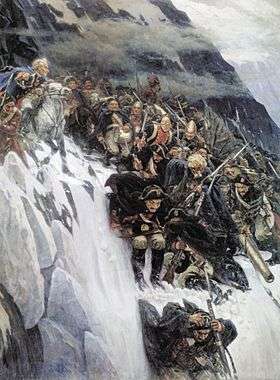
The Italian and Swiss expeditions of 1799 and 1800 were undertaken by a combined Austro-Russian army under overall command of the Russian General Alexander Suvorov against French forces in Piedmont, Lombardy and Switzerland as part of the Italian campaigns of the French Revolutionary Wars in general and the War of the Second Coalition in particular.
Italian campaign
Although by 1799 he was nearly seventy years old, Suvorov was one of the great soldiers of the age. He had won no fewer than sixty-three battles in the course of his long military career. He had been appointed field marshal during the reign of Catherine the Great, though he was dismissed by Tsar Paul, her son and successor, after the old soldier had the audacity to criticise the new imperial Infantry Code. He was only recalled after the Austrians specifically requested that he be appointed to command the combined Austro-Russian army to fight the French in Italy.
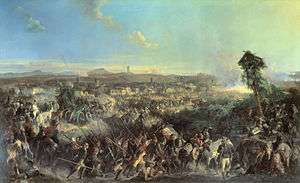
Taking command on 19 April, Suvorov moved his army westwards in a rapid march towards the Adda River; covering over 300 miles in just eighteen days. On 27 April, he defeated Jean Victor Moreau at the Battle of Cassano. Soon afterward, Suvorov wrote to a Russian diplomat: "The Adda is a Rubicon, and we crossed it over the bodies of our enemies."[1] On 29 April he entered Milan. Two weeks later, he moved on to Turin, having defeated Moreau yet again at Marengo. The king of Sardinia greeted him as a hero and conferred on him the rank of "Prince of the House of Savoy", among other honors.
From Naples, General MacDonald moved north to assist Moreau in June. Trapped between two armies, Suvorov took the bold decision to concentrate his whole force against MacDonald, beating the French at the Trebbia River, close to the spot of Hannibal's great victory in 218 BC. Marching back to the north, the indomitable soldier chased the whole French Army of Italy back towards the Riviera, taking the powerful fortress of Mantua on 28 July.
Moreau was relieved of command, to be replaced by Joubert. Pushing through the Bocchetta Pass, Joubert was defeated and killed in battle with Suvorov at Novi to the north of Genoa. Years later when Moreau, who was also present at Novi, was asked about Suvorov, he replied "What can you say of a general so resolute to a superhuman degree, and who would perish himself and let his army perish to the last man rather than retreat a single pace."[2]
Swiss campaign
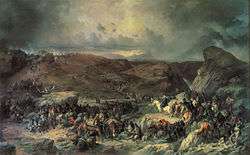

The Austrians and British switched emphasis to the campaign in the Low Countries. Despite his protests, Suvorov was ordered by Emperor Paul to transfer his troops to Switzerland, where they came under the command of Alexander Korsakov, who was defeated by Andre Massena at the Second Battle of Zürich. Massena, with 80,000 men at his disposal, then advanced on Suvorov's remaining force of 18,000 regulars and 5,000 Cossacks and Kalmyks. Suvorov could either retreat or be destroyed.
Avoiding Massena, the Russian commander withdrew on 6 October through the Panixer Pass, and then upwards into the 9,000 foot mountains of the Bündner Oberland, by then deep in snow. Massena was convinced that he would be trapped there and forced to surrender. Desperately ill-equipped and short of supplies, Suvorov nevertheless pushed on, finally reaching Chur on the Rhine with the bulk of his army intact. As he watched his ragged and starving soldiers march into camp the old soldier declared that "The Russian eagles outflew the Roman eagles," referring to his Hannibal-like crossing of the snow-capped Alps.[3]
Outcome
Although he succeeded in rescuing his army and did not lose a single battle, Suvorov's spectacular manoeuvring in Italy and Switzerland proved altogether useless. He was promoted to the rank of Generalissimo, the fourth in all of Russian history, and was recalled to Saint Petersburg by the Emperor Paul.
It was as a consequence of this campaign that Suvorov wrote Rules for the Conduct of Military Actions in the Mountains. He died in May 1800, having never fulfilled his greatest ambition – to meet Napoleon on the battlefield. A detailed account of the campaign was published in five volumes by Dmitry Milyutin in 1852–53.
Suvorov remains vividly remembered in the parts of the Swiss Alps his army passed through. Even though his famished troops plundered the countryside bare and his campaign was ultimately fruitless, the general is venerated as a liberator from the occupying French. Plaques adorn nearly every spot where he ate or slept in the Alps; chairs and beds he used are preserved as exhibits.[4] A life-size equestrian statue was unveiled in 1999 on the St. Gotthard Pass.
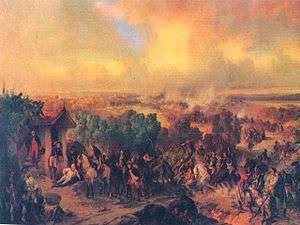 Suvorov victorious at the Battle of Trebbia. Alexander von Kotzebue, 1889.
Suvorov victorious at the Battle of Trebbia. Alexander von Kotzebue, 1889. Suvorov in Milan. Adolf Charlemagne (d. 1901).
Suvorov in Milan. Adolf Charlemagne (d. 1901).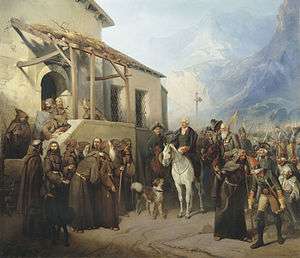 Suvorov at the St. Gotthard Pass. Adolf Charlemagne (d. 1901).
Suvorov at the St. Gotthard Pass. Adolf Charlemagne (d. 1901). Suvorov Crossing the Devil's Bridge. Robert Porter (d. 1842).
Suvorov Crossing the Devil's Bridge. Robert Porter (d. 1842)..jpg) Suvorov's March across the Alps (1904 mosaic from the Suvorov Museum).
Suvorov's March across the Alps (1904 mosaic from the Suvorov Museum). Suvorov Bidding Farewell to the Swiss People. Andrey Popov (d. 1896).
Suvorov Bidding Farewell to the Swiss People. Andrey Popov (d. 1896).- Monument to Alexander Suvorov and his fallen soldiers next to the Devil's Bridge, 1899.
Notes
- ↑ Latimer, 65
- ↑ Latimer, 68
- ↑ Latimer, 69
- ↑ Nussbaumer, Hannes. "Wie ein russischer General zum schweizerischen Volkshelden wurde ('How A Russian General Became A Swiss Folk Hero)". Berner Zeitung (in German). Retrieved 19 September 2009.
References
- Clausewitz, Carl von (1834). Hinterlassene Werke des Generals Carl von Clausewitz über Krieg und Kriegführung, zweiter teil : Die Feldzüge von 1799 in Italien und der Schweiz (in German). Berlin: F.Dümmler. OCLC 19596006.
- Dmitry Milyutin. The History of the War of Russia with France during the Reign of Emperor Paul I, vol. 1–9. St. Petersburg, 1852–1853.
- Latimer, Jon (December 1999). "War of the Second Coalition". Military History: 62–69.
- Longworth, Philip (1965). The Art of Victory: The Life and Achievements of Generalissimo Suvorov (1729–1800). New York: Holt, Rhinehart & Winston. OCLC 7139853.